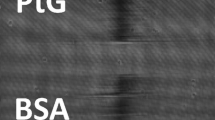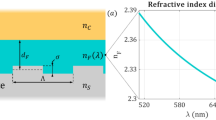Abstract
The incorporation of biomacromolecules onto silicon waveguiding microstructures constitutes a growing trend that pushes towards compact and miniaturized biosensing systems. This paper presents the integration of one-dimensional periodic nanostructures of proteins on the surface of micrometric silicon waveguides for transducing binding events between biomacromolecules. The study demonstrates this new bioanalytical principle by experimental results and theoretical calculations, and proves that rib waveguides (1-–1.6-µm width) together with protein gratings (495-–515-nm period) display suitable spectral responses for this optical biosensing system. Protein assemblies of bovine serum albumin are fabricated on the surface of silicon nitride waveguides, characterized by electron microscopy, and their response is measured by optical frequency domain reflectometry along the fabrication process and the subsequent stages of the biorecognition assays. Detection and quantification limits of 0.3 and 3.7 µg·mL−1, respectively, of specific antibodies are inferred from experimental dose–response curves. Among other interesting features, the results of this study point towards new miniaturized and integrated sensors for label-free bioanalysis.
Graphical abstract






Similar content being viewed by others
Data availability
The authors confirm that the data supporting the findings of this study are available within the article [and/or] its supplementary materials.
References
Khan SA, Khan NZ, Xie Y et al (2022) Optical sensing by metamaterials and metasurfaces: from physics to biomolecule detection. Adv Opt Mater 10:2200500. https://doi.org/10.1002/adom.202200500
Alba-Patiño A, Vaquer A, Barón E et al (2022) Micro- and nanosensors for detecting blood pathogens and biomarkers at different points of sepsis care. Microchim Acta 189:74. https://doi.org/10.1007/s00604-022-05171-2
Wang J, Maier SA, Tittl A (2022) Trends in nanophotonics-enabled optofluidic biosensors. Adv Opt Mater 10:2102366. https://doi.org/10.1002/adom.202102366
Amirjani A, Rahbarimehr E (2021) Recent advances in functionalization of plasmonic nanostructures for optical sensing. Microchim Acta 188:57. https://doi.org/10.1007/s00604-021-04714-3
Krämer J, Kang R, Grimm LM et al (2022) Molecular probes, chemosensors, and nanosensors for optical detection of biorelevant molecules and ions in aqueous media and biofluids. Chem Rev 122:3459–3636. https://doi.org/10.1021/acs.chemrev.1c00746
Yang T, Duncan TV (2021) Challenges and potential solutions for nanosensors intended for use with foods. Nat Nanotechnol 16:251–265. https://doi.org/10.1038/s41565-021-00867-7
Liu C, Huang J, Xu T, Zhang X (2022) Powering bioanalytical applications in biomedicine with light-responsive Janus micro-/nanomotors. Microchim Acta 189:116. https://doi.org/10.1007/s00604-022-05229-1
Luan E, Shoman H, Ratner D et al (2018) Silicon photonic biosensors using label-free detection. Sensors 18:3519. https://doi.org/10.3390/s18103519
Xu W, Liu J, Song D et al (2021) Rapid, label-free, and sensitive point-of-care testing of anti-SARS-CoV-2 IgM/IgG using all-fiber Fresnel reflection microfluidic biosensor. Microchim Acta 188:261. https://doi.org/10.1007/s00604-021-04911-0
Gupta R, Goddard NJ (2020) Leaky waveguides (LWs) for chemical and biological sensing−a review and future perspective. Sensors Actuators B Chem 322:128628. https://doi.org/10.1016/j.snb.2020.128628
Ettabib MA, Marti A, Liu Z et al (2021) Waveguide enhanced raman spectroscopy for biosensing: a review. ACS Sensors 6:2025–2045. https://doi.org/10.1021/acssensors.1c00366
Steglich P, Hülsemann M, Dietzel B, Mai A (2019) Optical biosensors based on silicon-on-insulator ring resonators: a review. Molecules 24:519. https://doi.org/10.3390/molecules24030519
Soler M, Estevez MC, Cardenosa-Rubio M et al (2020) How nanophotonic label-free biosensors can contribute to rapid and massive diagnostics of respiratory virus infections: COVID-19 case. ACS Sensors 5:2663–2678. https://doi.org/10.1021/acssensors.0c01180
Pawar D, Kale SN (2019) A review on nanomaterial-modified optical fiber sensors for gases, vapors and ions. Microchim Acta 186:253. https://doi.org/10.1007/s00604-019-3351-7
Artundo I (2017) Photonic Integration: new applications are visible. Opt Photonik 12:22–25. https://doi.org/10.1002/opph.201700015
Chen Z, Shi Y, Wei M, et al (2023) A universal approach to high‐index‐contrast flexible integrated photonics. Adv Opt Mater 11. https://doi.org/10.1002/adom.202202824
Chandrasekar R, Lapin ZJ, Nichols AS et al (2019) Photonic integrated circuits for Department of Defense-relevant chemical and biological sensing applications: state-of-the-art and future outlooks. Opt Eng 58:1. https://doi.org/10.1117/1.OE.58.2.020901
Ma Y, Zong Y, Yin H et al (2021) 2D Optical Waveguides based on hierarchical organic semiconductor single crystals. Adv Opt Mater 9:2101481. https://doi.org/10.1002/adom.202101481
Nikolaidou K, Condelipes PGM, Caneira CRF et al (2022) Monolithically integrated optical interference and absorption filters on thin film amorphous silicon photosensors for biological detection. Sensors Actuators B Chem 356:131330. https://doi.org/10.1016/j.snb.2021.131330
Juste-Dolz A, Fernández E, Puchades R et al (2023) Patterned biolayers of protein antigens for label-free biosensing in cow milk allergy. Biosensors 13:214. https://doi.org/10.3390/bios13020214
Loget G, Corn RM (2014) Silica nanowire arrays for diffraction‐based bioaffinity sensing. Chem Eur J 20:10802–10810. https://doi.org/10.1002/chem.201304800
Avella-Oliver M, Ferrando V, Monsoriu JA et al (2018) A label-free diffraction-based sensing displacement immunosensor to quantify low molecular weight organic compounds. Anal Chim Acta 1033:173–179. https://doi.org/10.1016/j.aca.2018.05.060
Gatterdam V, Frutiger A, Stengele K-P et al (2017) Focal molography is a new method for the in situ analysis of molecular interactions in biological samples. Nat Nanotechnol 12:1089–1095. https://doi.org/10.1038/nnano.2017.168
Blickenstorfer Y, Borghi L, Reichmuth AM et al (2021) Total internal reflection focal molography (TIR-M). Sensors Actuators B Chem 349:130746. https://doi.org/10.1016/j.snb.2021.130746
Juste-Dolz A, Delgado-Pinar M, Avella-Oliver M et al (2021) BIO bragg gratings on microfibers for label-free biosensing. Biosens Bioelectron 176:112916. https://doi.org/10.1016/j.bios.2020.112916
Sypabekova M, Korganbayev S, González-Vila Á et al (2019) Functionalized etched tilted fiber Bragg grating aptasensor for label-free protein detection. Biosens Bioelectron 146:111765. https://doi.org/10.1016/j.bios.2019.111765
Chiavaioli F, Baldini F, Tombelli S et al (2017) Biosensing with optical fiber gratings. Nanophotonics 6:663–679. https://doi.org/10.1515/nanoph-2016-0178
Soares MS, Vidal M, Santos NF et al (2021) Immunosensing based on optical fiber technology: recent advances. Biosensors 11:305. https://doi.org/10.3390/bios11090305
Frutiger A, Tanno A, Hwu S et al (2021) Nonspecific Binding—fundamental concepts and consequences for biosensing applications. Chem Rev 121:8095–8160. https://doi.org/10.1021/acs.chemrev.1c00044
Juste-Dolz A, Delgado-Pinar M, Avella-Oliver M et al (2022) Denaturing for nanoarchitectonics: local and periodic UV-laser photodeactivation of protein biolayers to create functional patterns for biosensing. ACS Appl Mater Interfaces 14:41640–41648. https://doi.org/10.1021/acsami.2c12808
Rumpf RC, Garcia CR, Berry EA, Barton JH (2014) Finite-difference frequency-domain algorithm for modeling electromagnetic scattering from general anisotropic objects. Prog Electromagn Res B 61:55–67. https://doi.org/10.2528/PIERB14071606
Zhu Z, Brown T (2002) Full-vectorial finite-difference analysis of microstructured optical fibers. Opt Express 10:853. https://doi.org/10.1364/OE.10.000853
Freeman NJ, Peel LL, Swann MJ et al (2004) Real time, high resolution studies of protein adsorption and structure at the solid-liquid interface using dual polarization interferometry. J Phys Condens Matter 16:0–4. https://doi.org/10.1088/0953-8984/16/26/023
Micó G, Gargallo B, Pastor D, Muñoz P (2019) Integrated optic sensing spectrometer: concept and design. Sensors 19:1018. https://doi.org/10.3390/s19051018
Bru LA, Pastor D, Muñoz P (2021) Advanced and versatile interferometric technique for the characterization of photonic integrated devices. Opt Express 29:36503. https://doi.org/10.1364/OE.435683
Ding Z, Wang C, Liu K et al (2018) Distributed optical fiber sensors based on optical frequency domain reflectometry: a review. Sensors 18:1072. https://doi.org/10.3390/s18041072
Hua P, Ding Z, Liu K et al (2023) Distributed optical fiber biosensor based on optical frequency domain reflectometry. Biosens Bioelectron 228:115184. https://doi.org/10.1016/j.bios.2023.115184
Vörös J (2004) The density and refractive index of adsorbing protein layers. Biophys J 87:553–561. https://doi.org/10.1529/biophysj.103.030072
Bernard A, Renault JP, Michel B et al (2000) Microcontact printing of proteins. Adv Mater 12:1067–1070. https://doi.org/10.1002/1521-4095(200007)12:14%3c1067::AID-ADMA1067%3e3.0.CO;2-M
Juste-Dolz A, Avella-Oliver M, Puchades R, Maquieira A (2018) Indirect microcontact printing to create functional patterns of physisorbed antibodies. Sensors (Switzerland) 18. https://doi.org/10.3390/s18093163
Wang J, Sanchez MM, Yin Y et al (2020) Silicon-based integrated label-free optofluidic biosensors: latest advances and roadmap. Adv Mater Technol 5:1901138. https://doi.org/10.1002/admt.201901138
Delamarche E, Pereiro I, Kashyap A, Kaigala GV (2021) Biopatterning: the art of patterning biomolecules on surfaces. Langmuir 37:9637–9651. https://doi.org/10.1021/acs.langmuir.1c00867
Acknowledgements
The authors acknowledge Instituto de Microelectrónica de Barcelona CNM-CSIC for the support in the fabrication of the measured chip samples on the multiproject CNM-VLC silicon nitride technology platform.
Funding
Funding was provided by grants PID2019-110713RB-I00, TED2021-132584B-C21, and PID2019-110877GB-I00 funded by MCIN/AEI/https://doi.org/10.13039/501100011033 and co-funded by “ERDF A way of making Europe”, Ministerio de Economía y Competitividad (TEC2016-80385-P), Generalitat Valenciana (PROMETEO/2020/094, PROMETEO/2021/015, IDIFEDER/2021/046), and Universitat Politècnica de València (PAID-06–22).
Author information
Authors and Affiliations
Corresponding authors
Ethics declarations
Competing interests
The authors declare no competing interests.
Additional information
Publisher's note
Springer Nature remains neutral with regard to jurisdictional claims in published maps and institutional affiliations.
Supplementary Information
Below is the link to the electronic supplementary material.
Rights and permissions
Springer Nature or its licensor (e.g. a society or other partner) holds exclusive rights to this article under a publishing agreement with the author(s) or other rightsholder(s); author self-archiving of the accepted manuscript version of this article is solely governed by the terms of such publishing agreement and applicable law.
About this article
Cite this article
Juste-Dolz, A., Fernández, E., Micó, G. et al. Surface Bragg gratings of proteins patterned on integrated waveguides for (bio)chemical analysis. Microchim Acta 191, 63 (2024). https://doi.org/10.1007/s00604-023-06124-z
Received:
Accepted:
Published:
DOI: https://doi.org/10.1007/s00604-023-06124-z




